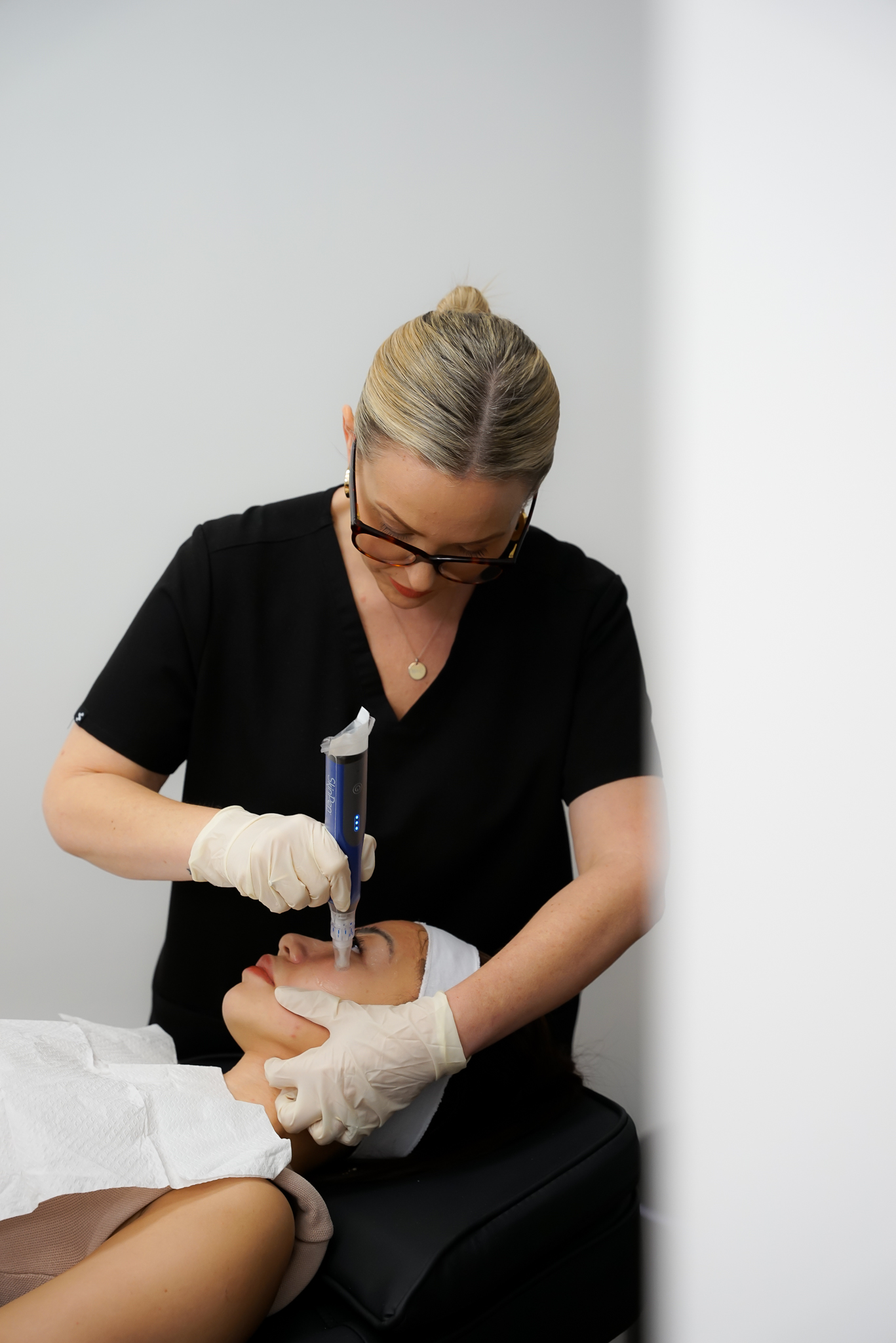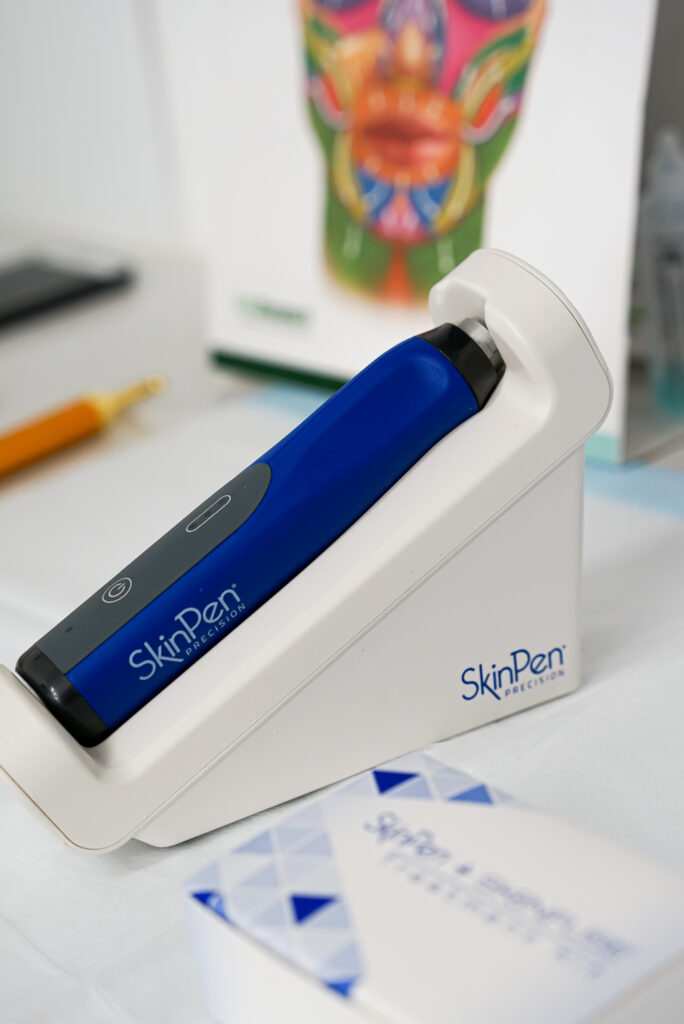
Smooth the skin with Microneedling
Microneedling with Skin Pen is a minimally invasive cosmetic procedure designed to improve skin texture, tone, and overall appearance. During the treatment, fine, short needles create controlled micro-injuries in the skin, which triggers the body’s natural healing response and stimulates the production of collagen and elastin, two essential proteins that help keep the skin firm and smooth.
Microneedling can effectively address a variety of skin concerns, including fine lines, wrinkles, acne scarring, pigmentation issues, and uneven skin texture.
The treatment is performed by a Registered Nurse using a SkinPen device, which allows for adjustable needle depths tailored to your individual skin needs.
Although microneedling is generally well-tolerated, visible improvements typically take up to 3 months to fully appear. To achieve the best results, multiple treatments are usually recommended, spaced several weeks apart. This versatile treatment can help improve concerns like acne scarring, surgical scars, and pigmentation, offering a significant improvement in skin texture and overall appearance.

How Does Microneedling Work?
Microneedling, also known as collagen induction therapy, is a minimally invasive procedure that uses a device equipped with fine needles to create small, micro-injuries in the skin’s surface. These micro-injuries stimulate the skin’s natural healing process, prompting an increase in collagen and elastin production, two essential proteins that contribute to skin firmness, elasticity, and smoothness.
The depth of the needles can be customized to target specific skin concerns, such as fine lines, wrinkles, acne scarring, pigmentation, or uneven texture. By addressing different layers of the skin, microneedling encourages the body’s natural repair mechanisms and helps to improve the skin’s structure and appearance over time.
As the skin heals, fresh, rejuvenated skin cells are generated, resulting in smoother and more even skin. The treatment also enhances the absorption of skincare products, allowing for deeper penetration of active ingredients, thus boosting their effectiveness. Microneedling further promotes circulation, helping to refresh and restore the skin’s vitality.
With regular treatments, microneedling can address multiple skin concerns, from scarring to texture, offering a holistic solution for improving skin health and appearance.
What Can You Expect After A Session of Microneedling?
Immediately after your microneedling session, you can expect the treated area to be red and slightly swollen, which is completely normal and should subside within a few hours. Some individuals may experience mild discomfort, itching, or a burning sensation, but this typically fades quickly.
For the first 24 hours post-treatment, you should avoid using makeup, creams, or any skincare products except for the aftercare creams provided as part of your treatment. During this period, cleanse your face with water only, as your skin will be sensitive. Avoid using sunscreen for the first 24 hours and refrain from sun exposure, as your skin will be more susceptible. Additionally, it’s important to avoid excessive sweating, which can irritate the skin and slow down the healing process.
A few days after your session, you may notice mild dryness and flaking of the skin. This is a normal part of the healing process and can be managed by applying the aftercare creams included in your treatment. It’s essential to avoid using active ingredients or harsh skincare products for 7 days post-treatment to allow your skin to fully recover. By following these aftercare steps, you’ll ensure the best results from your microneedling treatment.
Pricing
Face
From $350
Face and Neck
From $400
Face, Neck & Decolletage
From $450
FAQs
How does microneedling work?
A microneedling treatment typically takes about 1 hour, depending on the size of the treatment area and the individual’s skin condition. The procedure itself is generally quick, with the majority of the time spent on preparing the skin and post-treatment care. A Registered Nurse will provide a more accurate estimate of the treatment duration during your consultation.
How long does a microneedling treatment take?
A microneedling treatment typically takes about 1 hour, depending on the size of the treatment area and the individual’s skin condition. The procedure itself is generally quick, with the majority of the time spent on preparing the skin and post-treatment care. A Registered Nurse will provide a more accurate estimate of the treatment duration during your consultation.
Will skin needling help with acne scarring and stretch marks?
Microneedling can help improve the appearance of both acne scars and stretch marks. The needle pricks stimulate the production of collagen and elastin, which can help fill in scars and improve the texture of the skin. However, the effectiveness of microneedling for acne scars and stretch marks may vary, and multiple treatments may be required to see the desired results.
What will my skin look like when I walk out of the clinic after microneedling?
The appearance of your skin after a microneedling session will vary depending on the extent of the treatment and your individual skin condition. You may experience redness and swelling, which typically subside within a few hours to a day after the procedure. Some individuals may experience mild peeling or flaking, but this is generally minimal and should subside within a few days. It is important to follow the aftercare instructions provided by your Registered Nurse to ensure the best results and minimize the risk of side effects.
Do I need to take time off work after a session?
Most individuals can return to work or normal activities within a day or two after the procedure, but some may experience redness and swelling that may last a bit longer. It is important to follow the aftercare instructions provided by your Registered Nurse to ensure the best results and minimize the risk of side effects. If you have any concerns or questions, it is best to consult with a Registered Nurse
What treatments help to treat scarring?
Treatments for scarring can include a variety of options, such as microneedling, laser therapy, chemical peels, and topical creams. The best treatment for scarring will depend on the type, location, and severity of the scars, as well as the individual’s skin type and concerns. It is important to consult with a Registered Nurse to determine the best course of action for your specific needs and goals. They can help you create a customized treatment plan that takes into account your skin type, health history, and desired outcomes.
What is the difference between Skin Needling and Fractional RF?
Skin needling and fractional radiofrequency (RF) are two different skin rejuvenation treatments that both aim to improve the appearance of fine lines, wrinkles, and scars. Skin needling uses fine needles to make tiny punctures in the skin, which stimulates the production of collagen and elastin, while fractional RF uses heat energy delivered through micro-pins to target deeper layers of the skin to tighten and smooth the skin. Both treatments can be effective, but the best choice will depend on the individual’s skin concerns, goals, and tolerance for downtime. A Registered Nurse can help determine which treatment is right for you.
How do I know if skin needling is right for me?
Skin needling may be right for you if you are looking to improve the appearance of fine lines, wrinkles, scars, or hyperpigmentation. It is best to consult with a Registered Nurse who can evaluate your skin type, concerns, and goals to determine if skin needling is the right choice for you. They can also discuss the potential risks and benefits, as well as any alternative treatments that may be more appropriate for your needs.
Is this treatment suitable during pregnancy?
It is not recommended to undergo microneedling treatment during pregnancy. The safety of cosmetic procedures during pregnancy is not well established, and it is best to avoid any treatments that could potentially harm you or your baby. If you are pregnant and considering cosmetic treatments, it is important to consult with your doctor to determine what is safe and appropriate for you. They can advise you on the best course of action and help you weigh the risks and benefits of any treatments you are considering.
How soon will I see the results of Microneedling?
The results of microneedling can vary depending on your skin condition and the number of treatments you receive. Generally, it may take up to 3-6 months to see noticeable results, as the skin’s healing process and collagen production take time. The most noticeable results usually appear after several weeks or months, with full benefits often achieved after multiple sessions. A customized treatment plan can be created by your Registered Nurse to ensure the best outcome for your skin.
How long will the results of microneedling last?
The results of microneedling can last for several months to a year, depending on the individual’s skin condition, the number of treatments performed, and their skincare routine. While some results may last longer than others, periodic touch-up treatments may be needed to maintain the improvements. A Registered Nurse can help you create a treatment plan that ensures long-lasting results.
Is microneedling safe?
Microneedling is generally considered safe when performed by a qualified professional, such as a Registered Nurse. However, as with any cosmetic procedure, there is always a risk of side effects or complications, such as redness, swelling, infection, or scarring. These risks are typically mild and temporary, and proper aftercare can help minimize them. It is important to use a reputable provider who follows proper sterilization techniques and uses high-quality equipment to ensure safety.
How many microneedling sessions do i need?
The number of microneedling sessions required will depend on your skin condition and your desired results. Some individuals may see noticeable improvements after just one or two sessions, while others may require several treatments to achieve the best outcome. A Registered Nurse can assess your skin and help determine the ideal number of treatments based on your skin’s needs and goals.
What is the downtime after a microneedling session?
Typically, the skin may be red and slightly swollen for a few hours to a day after the procedure. Some individuals may experience mild peeling or flaking, but this is generally minimal and should subside within a few days. It is important to follow your aftercare instructions and avoid sun exposure to protect your skin during the healing process. Most individuals can resume their normal activities soon after the procedure, but it’s important to give your skin time to heal.
Are there any side effects of microneedling?
Microneedling is generally safe, but there may be some side effects, including redness, swelling, bruising, or mild irritation. These side effects are usually temporary and subside within a few hours to days. In rare cases, more severe side effects like infection or scarring can occur, so it’s important to follow your Registered Nurse’s aftercare advice to minimize any risks.
What conditions can Microneedling treat?
Microneedling is effective for treating a variety of skin concerns, including fine lines, wrinkles, acne scars, hyperpigmentation, and enlarged pores. It also improves skin texture, tone, and appearance, making it a versatile and highly effective option for enhancing skin health.
